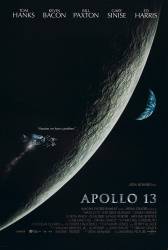Revealing mistake: In the final 1/2 hour there's a scene in which Kevin Bacon is drifting weightlessly in the lunar module, with a roll of duct tape floating nearby. Just during the last couple of seconds of this shot, suddenly he & the roll accelerate to the right. As everyone now knows the zero-g scenes were photographed on-board an aircraft which flies free-fall arcs for up to about 20 seconds before having to level off. The sudden acceleration on the set means that shot was filmed just as the plane was leveling off from a dive. (01:53:40)

Apollo 13 (1995)
1 revealing mistake - chronological order
Directed by: Ron Howard
Starring: Tom Hanks, Ed Harris, Kevin Bacon, Bill Paxton, Gary Sinise
Factual error: Moments before and during the lift-off of the Saturn V, Ken Mattingly is shown to be watching from a somewhat private grassy field. Wherever he is supposed to be, he is far too close to the launch pad. No unauthorized persons were allowed to be that close, and certainly not in an undisclosed and unsupervised area, not the least of which was for security reasons. The fact that Mattingly is an astronaut would not give him carte blanch to do this, and his training and discipline would prevent his ever attempting doing so in the first place. In reality, Mattingly was in Houston at Mission Control at the time. Otherwise it is a nice shot.
Fred Haise: It hurts when I urinate.
Jim Lovell: Well, you're not getting enough water.
Fred Haise: No, I'm drinkin' my rations, same as you... I think old Swigert gave me the clap. Been pissin' in my relief tube.
Jim Lovell: Well, that'd be a hot one at the debriefing for the flight surgeons... Another first for America's spacemen.

Trivia: The Captain of the Iwo-Jima who Tom Hanks talks to at the end of the movie is the real Apollo 13 astronaut Jim Lovell.
Join the mailing list
Separate from membership, this is to get updates about mistakes in recent releases. Addresses are not passed on to any third party, and are used solely for direct communication from this site. You can unsubscribe at any time.
Check out the mistake & trivia books, on Kindle and in paperback.




Answer: Spacecraft re-enter Earth's atmosphere at extremely high velocity (thousands of miles per hour). Atmospheric friction slows the spacecraft descent somewhat; but, without parachutes, the Apollo spacecraft would still reach the surface traveling at hundreds of miles per hour. Landing in water at such high speed would be like hitting concrete, which would of course be instantly fatal. Hence the necessity of multiple parachutes. The Apollo program (and all early U.S. manned space programs) chose to land in the ocean for two reasons: 1) It was easier to track spacecraft re-entry from horizon-to-horizon at sea without visual and radar obstacles, and; 2) It was faster and easier to position several Navy vessels in the general splashdown location, then deploy helicopters to rapidly retrieve the astronauts and their spacecraft.
Charles Austin Miller